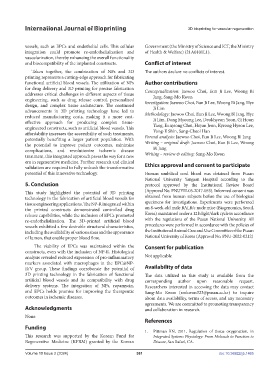Page 369 - IJB-10-2
P. 369
International Journal of Bioprinting 3D bioprinting for vascular regeneration
vessels, such as EPCs and endothelial cells. This cellular Government (the Ministry of Science and ICT, the Ministry
integration could promote re-endothelialization and of Health & Welfare) (21A0101L1).
vascularization, thereby enhancing the overall functionality
and biocompatibility of the implanted constructs. Conflict of interest
Taken together, the combination of NPs and 3D The authors declare no conflicts of interest.
printing represents a cutting-edge approach for fabricating
functional artificial blood vessels. The utilization of NPs Author contributions
for drug delivery and 3D printing for precise fabrication Conceptualization: Jaewoo Choi, Eun Ji Lee, Woong Bi
addresses critical challenges in different aspects of tissue Jang, Sang-Mo Kwon
engineering, such as drug release control, personalized Investigation: Jaewoo Choi, Eun Ji Lee, Woong Bi Jang, Hye
design, and complex tissue architecture. The continued Ji Lim
advancements in 3D printing technology have led to
reduced manufacturing costs, making it a more cost- Methodology: Jaewoo Choi, Eun Ji Lee, Woong Bi Jang, Hye
effective approach for producing complex tissue- Ji Lim, Dong Myoung Lee, Deokhyeon Yoon, Gi Hoon
engineered constructs, such as artificial blood vessels. This Yang, Eunjeong Choi, Hojun Jeon, Kyeong Hyeon Lee,
affordability increases the accessibility of such treatments, Yong-Il Shin, Sang-Cheol Han
potentially benefiting a larger patient population. With Formal analysis: Jaewoo Choi, Eun Ji Lee, Woong Bi Jang
the potential to improve patient outcomes, minimize Writing – original draft: Jaewoo Choi, Eun Ji Lee, Woong
complications, and revolutionize ischemic disease Bi Jang
treatment, this integrated approach paves the way for a new Writing – review & editing: Sang-Mo Kwon
era in regenerative medicine. Further research and clinical
validation are required to fully unleash the transformative Ethics approval and consent to participate
potential of this innovative technology. Human umbilical cord blood was obtained from Pusan
National University Yangsan Hospital according to the
5. Conclusion protocol approved by the Institutional Review Board
This study highlighted the potential of 3D printing (Approval No. PNUYH-05-2017-053). Informed consent was
technology in the fabrication of artificial blood vessels for obtained from human subjects before the use of biological
tissue engineering applications. The NP-R integrated within specimens for investigations. Experiments were performed
the printed constructs demonstrated controlled drug on 8-week-old male BALB/c nude mice (Biogenomics, Seoul,
release capabilities, while the inclusion of EPCs promoted Korea) maintained under a 12 h light/dark cycle in accordance
re-endothelialization. The 3D-printed artificial blood with the regulations of the Pusan National University. All
vessels exhibited a few desirable structural characteristics, procedures were performed in accordance with the policies of
including the availability of various sizes and the appearance the Institutional Animal Care and Use Committee of the Pusan
of lumen, that enable proper blood flow. National University of Korea (Approval No. PNU-2022-0212)
The viability of EPCs was maintained within the Consent for publication
constructs, even with the inclusion of NP-R. Histological
analysis revealed reduced expression of pro-inflammatory Not applicable
markers associated with macrophages in the EPC@NP-
R/V group. These findings corroborate the potential of Availability of data
3D printing technology in the fabrication of functional The data utilized in this study is available from the
artificial blood vessels and its compatibility with drug corresponding author upon reasonable request.
delivery systems. The integration of NPs, rapamycin, Researchers interested in accessing the data may contact
and EPCs holds promise for improving the therapeutic Sang-Mo Kwon (smkwon323@pusan.ac.kr) to inquire
outcomes in ischemic diseases. about data availability, terms of access, and any necessary
agreements. We are committed to promoting transparency
Acknowledgments and collaboration in research.
None.
References
Funding
1. Pittman RN, 2011, Regulation of tissue oxygenation, in
This research was supported by the Korean Fund for Integrated Systems Physiology: From Molecule to Function to
Regenerative Medicine (KFRM) granted by the Korean Disease, San Rafael, CA.
Volume 10 Issue 2 (2024) 361 doi: 10.36922/ijb.1465

